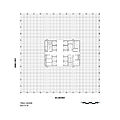| 140 William Street, Melbourne | |
|---|---|
 Building façade from William Street | |
 Interactive map of 140 William Street, Melbourne | |
| Record height | |
| Tallest in Melbourne from 1972 to 1975 [I] | |
| Preceded by | Marland House |
| Surpassed by | Optus Centre |
| General information | |
| Location | 140 William Street, Melbourne, Australia |
| Coordinates | 37°48′57″S144°57′31″E / 37.8158°S 144.9586°E |
| Completed | 1972 |
| Height | |
| Roof | 152 metres (499 ft) |
| Technical details | |
| Floor count | 41 |
| Design and construction | |
| Architect | Yuncken Freeman |
| Engineer | Irwinconsult Fazlur Rahman Khan |
140 William Street (formerly BHP House) is a 41-storey 152m tall steel, concrete and glass building located in the western end of the central business district of Melbourne, Victoria, Australia. Constructed between 1969 and 1972, BHP House was designed by the architectural practice Yuncken Freeman alongside engineers Irwinconsult, [1] with heavy influence of contemporary skyscrapers in Chicago, Illinois. The local architects sought technical advice from Bangladeshi-American structural engineer Fazlur Rahman Khan, of renowned American architectural firm Skidmore, Owings & Merrill, spending ten weeks at its Chicago office in 1968. [2] At the time, BHP House was known to be the tallest steel-framed building and the first office building in Australia to use a “total energy concept” – the generation of its own electricity using BHP natural gas. [3] The name BHP House came from the building being the national headquarters of BHP. [2] BHP House has been included in the Victorian Heritage Register (Number H1699) for significance to the State of Victoria for following three reasons: [4]
Contents
- Architectural – 140 William Street is one of the most noteworthy building designs by the Melbourne firm Yuncken Freeman.
- Technological – Its innovative structural application of steel and concrete, leading to open floor plates that are now a standard feature of high rise office buildings.
- Historical – The building signifies changes in Melbourne's CBD as it transformed into a major corporate centre.





